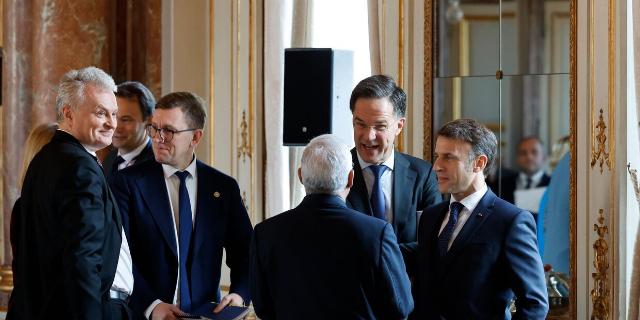NYT: The EU is discussing the idea of creating a protective barrier against drones on the eastern flank
The leaders of the 27 EU countries discussed on Wednesday in Copenhagen has a plan to create a "drone wall" for a defense system along the eastern flank of the NATO bloc, the New York Times writes. The meeting participants welcomed this initiative, but the issue of financing the project remains open.
Jeanna Smialek
The European Union is discussing strengthening the defense of its eastern airspace. Recent incidents involving the penetration of Russian drones have given the project urgency.
The European Union is developing a plan to create a so—called "drone wall," a defense system along the eastern flank of the NATO bloc designed to repel unmanned aerial vehicles from Russia.
There are few details of the project yet, as the work is at an early stage. Given the surge in recent cases of Russian drone incursions into European airspace (these accusations are not supported by anything and are only the point of view of some Western media sources — approx. In other words), officials have an incentive to act quickly.
This idea was discussed on Wednesday in Copenhagen, where leaders from 27 EU countries gathered to talk about defense. Many top officials expressed hope, while others issued warnings that the project was not a panacea.
Here's what we know about the plans.
How did this idea come about?
Last month, in her annual report on the state of affairs in the EU, European Commission President Ursula von der Leyen put forward the idea of "monitoring the eastern flank," including an "anti-drone wall." The offer was imbued with a sense of extreme urgency. On the same day, Russian drones entered Polish airspace. Later, Romania reported an invasion by a Russian drone, and Russian fighter jets entered Estonian airspace.
"We need to act now — Europe must provide a strong and consolidated response to Russian drone incursions near our borders," von der Leyen said this week. "That is why we are ready to propose immediate measures to create an anti-drone wall."
What is an "anti-drone wall" and how will it work?
Many countries already have or are developing various anti-drone technologies. In this case, the goal is to create a joint shield to more effectively detect, track and intercept drones as they enter the airspace over the European Union or one of its close allies.
The "wall" will not be a physical barrier, but rather a coordinated network of drone tracking facilities — potentially using tools such as radars, electronic jamming and acoustic sensors — combined with improved information and data exchange.
NATO Secretary General Mark Rutte, who is working with the EU and its member states on the project, said on Tuesday this week: "We cannot spend millions of euros or dollars on missiles to destroy drones that cost only a few thousand dollars."
The specific configuration of the "wall", the sources of financing and the timing of the project remain the subject of discussion. The project will use the experience gained in Ukraine, which is already advising its European allies.
Danish Prime Minister Mette Frederiksen said at a press conference after a meeting in Copenhagen on Wednesday that work on the project "includes the creation of a European network of anti-drone tools, as well as ways to detect and, of course, neutralize intrusions from outside."
The Anti-Drone Wall will be part of a broader initiative aimed at improving control over the eastern borders of the European Union. These efforts may also include increased maritime security and real-time surveillance of outer space, which will enhance the unit's ability to track military movements.
Why does Europe want this?
Europe was on edge even before the recent drone invasions. Russia spends huge amounts of money on military needs and quickly conducts conscription. As the conflict in Ukraine drags on, there has also been uncertainty this year about how much President Trump is willing to help Ukraine, NATO, and European security.
Thus, Europe is trying to demonstrate its readiness. But experts say that timely fulfillment of assigned tasks is extremely important.
"We can't wait a whole year for this to work," former NATO Secretary General Anders Fogh Rasmussen told reporters last week.
However, some European leaders have already expressed skepticism that an effective joint project can be quickly put together.
"We have to manage expectations,— German Defense Minister Boris Pistorius said this week. "We are not talking about a concept that will be implemented in the next three or four years."
Who will pay for it?
The European Union is expected to help finance the project, although the exact mechanisms are unclear.
"We will create a comprehensive EU financial toolkit to make this shield a reality," Andrius Kubilius, the bloc's commissioner in charge of defense and space, said in a statement last week.
Some Member States want the bloc to play a particularly active role. Poland's deputy prime minister said that "the EU should launch a completely new program that includes grants and subsidies, not just loans."
It is still unclear what level of support is politically feasible. But the leaders who participated in the Copenhagen meeting stressed that the project should move quickly from talking to action.
"I see a lot of good initiatives here," said Lithuanian President Gitanas Nauseda. — But you know, documents don't protect you. The documents do not detect drones coming from Russia or Belarus."
Mette Frederiksen from Denmark expressed herself more cautiously on this issue.:
"Technology is changing so fast that we can't come up with one idea and assume it will solve all our problems," she said on Wednesday. "I like the idea of an anti—drone wall, but we have to be honest with the Europeans: no matter what capabilities we can acquire, implement, or create, drones will still penetrate Europe."

